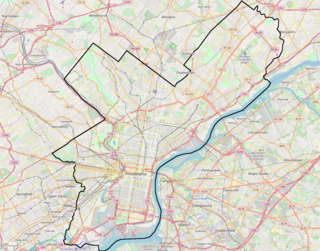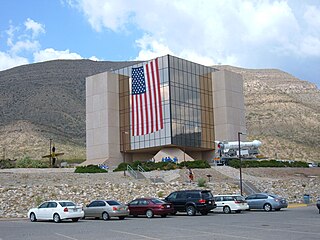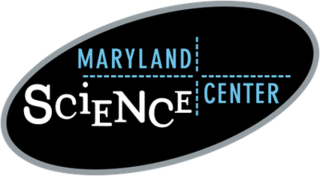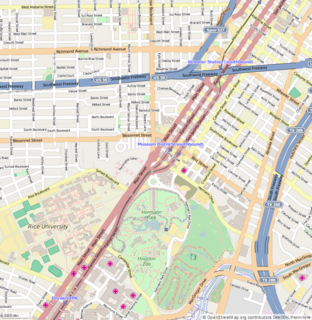
The Franklin Institute is a science museum and the center of science education and research in Philadelphia, Pennsylvania. It is named after the American scientist and statesman Benjamin Franklin, and houses the Benjamin Franklin National Memorial. Founded in 1824, the Franklin Institute is one of the oldest centers of science education and development in the United States.

The New Mexico Museum of Space History is a museum and planetarium complex in Alamogordo, New Mexico, US dedicated to artifacts and displays related to space flight and the space age. It includes the International Space Hall of Fame. The Museum of Space History highlights the role that New Mexico has had in the U. S. space program, and is one of eight museums administered by the New Mexico Department of Cultural Affairs. The museum has been accredited by American Alliance of Museums since 1993. The museum is also a Smithsonian Affiliate.

The Oregon Museum of Science and Industry is a science and technology museum in Portland, Oregon, United States. It contains three auditoriums, including a large-screen theatre, planetarium, and exhibition halls with a variety of hands-on permanent exhibits focused on natural sciences, industry, and technology. Transient exhibits span a wider range of disciplines.

Carnegie Museums of Pittsburgh are four museums that are operated by the Carnegie Institute headquartered in the Carnegie Institute complex in the Oakland neighborhood of Pittsburgh, Pennsylvania. The Carnegie Institute complex, which includes the original museum, recital hall, and library, was added to the National Register of Historic Places on March 30, 1979.

The Carnegie Science Center is one of the four Carnegie Museums of Pittsburgh, Pennsylvania. It is located in the Chateau neighborhood. It is located across the street from Heinz Field.

The Maryland Science Center, located in Baltimore's Inner Harbor, opened to the public in 1976. It includes three levels of exhibits, a planetarium, and an observatory. It was one of the original structures that drove the revitalization of the Baltimore Inner Harbor from its industrial roots to a thriving downtown destination. In 1987, an IMAX theater was added, but the museum continued to show its age as the end of the 20th century approached. In 2004, a large addition to the property was opened, and the modernized hands-on exhibits now include more than two dozen dinosaur skeletons. Subjects that the center displays include physical science, space, Earth science, the human body, and blue crabs that are native to the Chesapeake Bay.

The Saint Louis Science Center, founded as a planetarium in 1963, is a collection of buildings including a science museum and planetarium in St. Louis, Missouri, on the southeastern corner of Forest Park. With over 750 exhibits in a complex of over 300,000 square feet (28,000 m2), it is among the largest of its type in the United States.

COSI, officially the Center of Science and Industry, is a science museum and research center in Columbus, Ohio. Originally opened in 1964, COSI was moved to a 320,000-square-foot (30,000 m2) facility designed by Japanese architect Arata Isozaki along a bend in the Scioto River in the Franklinton neighborhood in 1999. COSI features more than 300 interactive exhibits throughout themed exhibition areas.

Telus World of Science Edmonton (TWOSE) is a broad-based science centre in Edmonton, Alberta, Canada, operated by the (non-profit) Edmonton Space & Science Foundation. The centre is located on the southwest corner of Coronation Park in the neighborhood of Woodcroft. It is currently a member of both the Association of Science-Technology Centers (ASTC) and the Canadian Association of Science Centres (CASC).

Space Camp is an educational camp in Huntsville, Alabama, on the grounds of the U.S. Space & Rocket Center museum at NASA's Marshall Space Flight Center. It provides residential and educational programs for children and adults on themes such as space exploration, aviation and robotics. The camp is run by a state government agency, the Alabama Space Science Exhibit Commission. More than 900,000 campers have graduated since 1982, including several who became astronauts.
Science Museum Oklahoma is a science museum in Oklahoma City, Oklahoma. The museum is home to the Kirkpatrick Planetarium, the International Gymnastics Hall of Fame and a number of specialized galleries. The facility covers over 390,000 square feet, which makes it one of the largest science museums in the nation. It began as the Kirkpatrick Planetarium in 1958 with major additions in 1980, 1985, 2000 and 2007.

The Houston Museum of Natural Science is a natural history museum located on the northern border of Hermann Park in Houston, Texas, United States. The museum was established in 1909 by the Houston Museum and Scientific Society, an organization whose goals were to provide a free institution for the people of Houston focusing on education and science. Museum attendance totals over two million visitors each year. The museum complex consists of a central facility with four floors of natural science halls and exhibits, the Burke Baker Planetarium, the Cockrell Butterfly Center, and the Wortham Giant Screen Theatre. The museum is one of the most popular in the United States and ranks just below New York City's American Museum of Natural History and Metropolitan Museum of Art and the M. H. de Young Memorial Museum in San Francisco in most attendance amongst non-Smithsonian museums. Much of the museum's popularity is attributed to its large number of special or guest exhibits.

The Evansville Museum of Arts, History & Science is a general-interest museum located on the Ohio riverfront in downtown Evansville, Indiana, United States. Founded in 1904, it is one of Southern Indiana's most established and significant cultural institutions, with comprehensive collections in art, history, anthropology and science. It has a permanent collection of over 30,000 objects including fine arts, decorative arts, historic documents and photographs, and anthropologic and natural history artifacts. Also on the Museum's campus is the Evansville Museum Transportation Center, featuring Southern Indiana transportation artifacts from the late 19th through the mid-20th centuries. The museum is accredited by the American Alliance of Museums.

The Rose Center for Earth and Space is a part of the American Museum of Natural History in New York City. The Center's complete name is The Frederick Phineas and Sandra Priest Rose Center for Earth and Space. The main entrance is located on the northern side of the museum on 81st Street near Central Park West in Manhattan's Upper West Side. Completed in 2000, it includes the new Hayden Planetarium, the original of which was opened in 1935 and closed in 1997. Neil deGrasse Tyson is its first and, to date, only director.

The Phillip and Patricia Frost Museum of Science is a science museum, planetarium, and aquarium located in Miami, Florida, US. Originally located in Coconut Grove, the museum relocated to Museum Park in the downtown area adjacent to the Perez Art Museum Miami in 2017.

The Michigan Science Center(MiSci) is a Smithsonian-affiliate science museum in Detroit, Michigan. The mission of the Michigan Science Center is to inspire curious minds of all ages to discover, explore and appreciate science, technology, engineering and math (STEM) in a creative, dynamic learning environment. As a 501(c)(3) nonprofit organization, MiSci relies on the generous support of donors, sponsors, community partners and members.

The South Florida Science Center and Aquarium (SFSCA) is located at 4801 Dreher Trail North, West Palm Beach, Florida, USA. Founded in 1959, the goal of the organization is to open every mind to science through the strategic programming of interactive exhibits and engaging community-based camps and events. The SFSCA has expanded since its creation and now houses over 50 hands-on exhibits, a planetarium, a 3000 square foot aquarium, a miniature golf course, and a large exhibit space that displays a temporary travelling exhibit. The SFSCA is a member of the ASTC program, which offers a membership that is redeemable at other ASTC science and technology centers around the world. The SFSCA occupies Dreher Park alongside the Palm Beach Zoo and offers deals for entrance to both facilities. The phone number for the South Florida Science Center and Aquarium is (561) 832-1988.

The Museum of Science & History (MOSH) is a museum in Jacksonville, Florida. It is a private, non-profit institution located on the Southbank Riverwalk, and the city's most visited museum. It specializes in science and local history exhibits. It features a large traveling exhibit that changes quarterly, three floors of permanent and signature exhibits, and the Bryan-Gooding Planetarium.

The Eugene Science Center, located in Alton Baker Park in Eugene, Oregon, United States, is a science and technology center for children, families, and school groups. The 10,000-square-foot (930 m2) museum near Autzen Stadium features changing interactive exhibits, planetarium shows, camp programs, special events and other science and technology-related education programs. Eugene Science Center is an independent 501(c)(3) non-profit organization governed by a volunteer board of directors. Its mission is: "To engage children, excite their curiosity, inspire them toward a lifetime love of science, and empower them to use science and technology to improve their communities." Eugene Science Center is the only science museum in Lane County and surrounding counties.

The Texas Museum of Science & Technology (TXMOST) opened in March 2015 in an interim facility in Cedar Park, Texas.



















